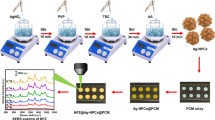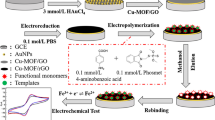Abstract
A sensitive label-free DNA hybridization biosensing platform was fabricated based on the synergistic effect of polyaniline nanotubes (PANInt) and poly-L-lysine (pLys). The composite of pLys and PANInt was coated onto the carbon paste electrode (CPE) to form a uniform and very stable nanocomposite membrane. The pLys in the composite film not only acts as a membrane to retain good electron transfer capability of PANInt even at physiological pH, but also possesses fine biocompatibility for bio-analytes. DNA probes with negatively charged phosphate groups were readily linked to the positively charged pLys surface due to the strong electrostatic affinity. The synergistic effect of PANInt and pLys could significantly enhance the sensitivity of DNA hybridization recognition. The phosphinothricin acetyltransferase (PAT) gene fragment from transgenic corn and the polymerase chain reaction amplification of the terminator of nopaline synthase gene from the real sample of a kind of transgenic soybean were detected by this DNA electrochemical biosensor via label-free impedance method. This stable composite gives convenient permselectivity properties as a transducer material for the design of modern electrochemical impedance biosensor using [Fe(CN)6]3−/4− as an indicator.
Similar content being viewed by others
References
Liu HK, Yang C, Wei ZM. Heat shock-regulated site-specific excision of extraneous DNA in transgenic plants. Plant Sci, 2005, 168: 997–1003
Peng H, Soeller C, Vigar NA, Caprio V, Travas-Sejdic J. Label-free detection of DNA hybridization based on a novel functionalized conducting polymer. Biosens Bioelectron, 2007, 22: 1868–1873
Chen JH, Zhang J, Wang K, Lin XH, Huang LY, Chen GN. Electrochemical biosensor for detection of BCR/ABL fusion gene using locked nucleic acids on 4-aminobenzenesulfonic acid-modified glassy carbon electrode. Anal Chem, 2008, 80: 8028–8034
Liu S, Chen M, Li JD, Zhang HB, Wang JQ, Yang SR. Application of peptide nucleic acids containing azobenzene self-assembled electrochemical biosensors in detecting DNA sequences. Sci China Ser B-Chem, 2009, 52(7): 1009–1013
Thompson LA, Kowalik J, Josowicz M, Janata J. Label-free DNA hybridization probe based on a conducting polymer. J Am Chem Soc, 2003, 125: 324–325
Gu HR, Su XD, Loh KP. Electrochemical impedance sensing of DNA hybridization on conducting polymer film-modified diamond. J Phys Chem B, 2005, 109: 13611–13618
Zhao W, Sun SX, Xu JJ, Chen HY, Cao XJ, Guan X H. Electrochemical identification of the property of peripheral nerve fiber based on a biocompatible polymer film via in situ incorporating gold nanoparticles. Anal Chem, 2008, 80: 3769–3776
Luz RDCS, Damos FS, Tanaka AA, Kubota LT. Dissolved oxygen sensor based on cobalt tetrasulphonated phthalocyanine immobilized in poly-l-lysine film onto glassy carbon electrode. Sens Actuators B, 2006, 114: 1019–1027
Monterroso SCC, Carapuca HM, Duarte AC. Mixed polyelectrolyte coatings on glassy carbon electrodes: ion-exchange, permselectivity properties and analytical application of poly-l-lysine-poly (sodium 4-styrenesulfonate)-coated mercury film electrodes for the detection of trace metals. Talanta, 2006, 68: 1655–1662
Jiang C, Yang T, Jiao K, Gao HW. A DNA electrochemical sensor with poly-l-lysine/single-walled carbon nanotubes films and its application for the highly sensitive EIS detection of PAT gene fragment and PCR amplification of NOS gene. Electrochim Acta, 2008, 53: 2917–2924
Singh S, Solanki PR, Pandey MK, Malhotra BD. Covalent immobilization of cholesterol esterase and cholesterol oxidase on polyaniline films for application to cholesterol biosensor. Anal Chim Acta, 2006, 568: 126–132
Manesh KM, Santhosh P, Komathi S, Kim NH, Park JW, Gopalan AI, Lee KP. Electrochemical detection of celecoxib at a polyaniline grafted multiwall carbon nanotubes modified electrode. Anal Chim Acta, 2008, 626: 1–9
Sheng QL, Zheng JB. Bienzyme system for the biocatalyzed deposition of polyaniline templated by multiwalled carbon nanotubes: a biosensor design. Biosens Bioelectron, 2009, 24: 1621–1628
Morrin A, Ngamna O, Killard AJ, Moulton SE, Smyth MR, Wallace GG. An amperometric enzyme biosensor fabricated from polyaniline nanoparticles. Electroanalysis, 2005, 17: 423–430
Ambrosi A, Morrin A, Smyth MR, Killard AJ. The application of conducting polymer nanoparticle electrodes to the sensing of ascorbic acid. Anal Chim Acta, 2008, 609: 37–43
Zhao M, Wu XM, Cai CX. Polyaniline nanofibers: synthesis, characterization, and application to direct electron transfer of glucose oxidase. J Phys Chem C, 2009, 113: 4987–4996
Wang ZY, Liu XN, Wu P, Cai CX. Detection of glucose based on direct electron transfer reaction of glucose oxidase immobilized on highly ordered polyaniline nanotubes. Anal Chem, 2009, 81: 1638–1645
Zhang W, Yang T, Huang DM, Jiao K, Li GC. Synergistic effects of nano-ZnO/multi-walled carbon nanotubes/chitosan nanocomposite membrane for the sensitive detection of sequence-specific of PAT gene and PCR amplification of NOS gene. J Membr Sci, 2008, 325: 245–251
Park JY, Kwon SH, Park JW, Park SM. Label-free detection of DNA molecules on the dendron based self-assembled monolayer by electrochemical impedance spectroscopy. Anal Chim Acta, 2008, 619: 37–42
Suni II. Impedance methods for electrochemical sensors using nanomaterials. Trends Anal Chem, 2008, 27: 604–611
Author information
Authors and Affiliations
Corresponding author
Rights and permissions
About this article
Cite this article
Yang, T., Jiang, C., Zhang, W. et al. Improved electrochemical performances of polyaniline nanotubes-poly-L-lysine composite for label-free impedance detection of DNA hybridization. Sci. China Chem. 53, 1371–1377 (2010). https://doi.org/10.1007/s11426-010-3162-5
Received:
Accepted:
Published:
Issue Date:
DOI: https://doi.org/10.1007/s11426-010-3162-5




